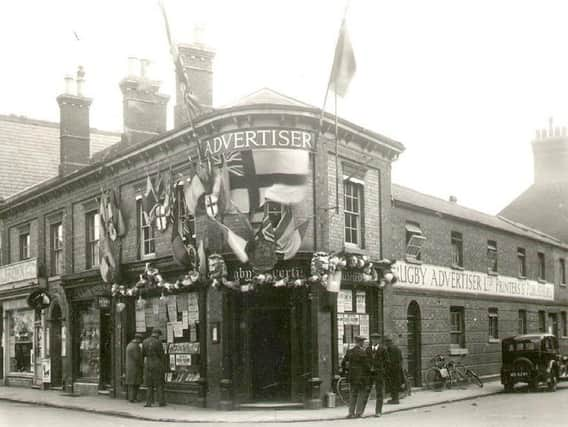The Rugby man who invented tabloid journalism in the 1700s... and his grisly report on Dick Turpin's execution


Walk into any corner shop, newsagents or supermarket, and your senses will soon collide head-on with that mass of type and colour that make up the racks where the papers and magazines are stored.
Most of us probably take this for granted, perhaps regarding the news stands as having always been there. But have you ever wondered about the origins of your favourite newspaper or magazine?
Advertisement
Hide AdAdvertisement
Hide AdThe first newspapers were just propaganda sheets published by the opposing sides during the Civil Wars of the 1600s. But things would move on apace during the next century and for that we have to thank a man from… yes, you’ve guessed it, Rugby.
The son of a cobbler, Edward Cave was born in Newton in 1691, attending Rugby School. However, it seems that he was expelled after being accused of stealing from the headmaster .
Cave worked at a number of different jobs, such as selling timber, writing and printing. But after a while, he came up with the idea of a periodical that would cover every subject the educated public was interested in, from commerce to poetry .
He tried to get some London printers and booksellers to take up the idea.
Advertisement
Hide AdAdvertisement
Hide AdWhen no one showed any interest, Cave took on the job by himself. The Gentleman’s Magazine was started in 1731 and soon became the most important and most copied periodical of its time. And it also made Cave a very rich man.
Cave was a smart businessman. He gave all his energy to the magazine, and hardly ever left its offices at St John’s Gate, Clerkenwell.
He made use of a lot of writers, the most famous being legendary wit and compiler of the first English dictionary, Samuel Johnson .
Cave himself often sent in items to the magazine under the pen name of Sylvanus Urban.
Advertisement
Hide AdAdvertisement
Hide AdHe also appears to have been a man of many talents. He patented a spinning machine, and in 1742, bought a cotton mill in Northampton.
This was possibly the first water-powered spinning mill in the world. Unfortunately it failed around 1761.
However, Edward Cave is best remembered as the founder of modern tabloid journalism, realising that successful publications not only informed, but also entertained their readers with stories written in a sensationalist style.
In those days, public executions attracted large crowds, and if the condemned person was famous, then there would also be a huge appetite to read about the grisly details.
Advertisement
Hide AdAdvertisement
Hide AdOn May 4, 1737, gamekeeper Thomas Morris was shot and killed while attempting to capture the notorious highwayman Dick Turpin Turpin fled to Yorkshire and changed his name to John Palmer.
The next month, Edward Cave launched an appeal in The Gentleman’s Magazine to find the killer of Morris. The description of the highwayman was ‘About 5ft 9ins high, brown complexion, very much marked with the small pox, his cheek bones broad, his face thinner towards the bottom, his visage short, pretty upright and pretty broad about the shoulders.’
A year went by, and there was still no sign of Turpin. But then came a dramatic development – a man answering his description had been arrested and thrown in jail.
Apparently, having shot his landlord’s cockerel, a drunken Turpin threatened to kill the landlord, which led to his arrest. And he might have got away with it, had he not written to his brother-in-law asking for help.
Advertisement
Hide AdAdvertisement
Hide AdBut his brother refused to pay the sixpence due on the letter. The letter was returned to the local post office, where Turpin’s old schoolmaster, James Smith, recognised his handwriting.
The game was up. After a short trial, Turpin was found guilty on two charges of horse theft and sentenced to death.
On April 7, 1739, Turpin bought a new coat and shoes, also hiring five professional mourners. He was put in to an open cart and sent through the streets of York. He waved and bowed to the crowd as he was led to the gallows.
This is an extract from the lengthy account that appeared in the next edition of The Gentleman’s Magazine.
Advertisement
Hide AdAdvertisement
Hide Ad‘Turpin behaved in an undaunted manner; as he mounted the ladder, feeling his right leg tremble, he spoke a few words to the topsman, then threw himself off, and expired in a few minutes.’
There is another local link to the Dick Turpin story. The outlaw regularly robbed travellers on the Watling Street, and used the deserted village of Stretton Baskerville, near Hinckley as a place to hide.
This former settlement was the most northerly village in the Knightlow Hundred, the ancient name for the area that still includes many of the villages around Rugby.
In the 18th century, it was the haunt of criminals, the destitute and the dispossessed. Dick Turpin’s ghost is still said to haunt this section of the Watling Street, reputedly searching for the highwaymen’s lost buried treasure.
Advertisement
Hide AdAdvertisement
Hide AdAs for Edward Cave, he died in bed with his boots off in January, 1754. He is buried at St James Church, Clerkenwell, London.
John Phillpott writes about Edward Cave in his book Go and Make the Tea, Boy! published by Brewin Books of Redditch.